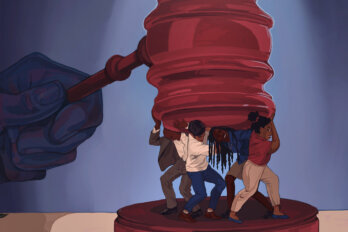Fallon Farinacci was nine years old when her mother and father were murdered, in the Manitoba Métis community of Saint Eustache, in 1993. She now lives near Niagara Falls, Ontario, and is married with three children. For many years, she thought she’d already come to terms with her parents’ deaths. But, in October 2017, she became one of 1,500 witnesses who testified at the National Inquiry into Missing and Murdered Indigenous Women and Girls (MMIWG). At the MMIWG hearings in Winnipeg, she told those assembled that she had been in the house when her mother’s stalker shot both of her parents and then himself. She spoke about how her younger brother had witnessed their deaths and how her older brother had later died by suicide.
The experience of telling her family’s story, she says, “opened my eyes to the emotional wounds I was suppressing.” After the murder of her parents, Farinacci had been displaced from her Métis community. She grew up away from the culture that had, for generations, shaped her family. She always spoke openly about her parents, believing that, “if you keep [loved ones] alive when you’re talking, that’s what’s going to help.” But being at the inquiry, surrounded by those who shared not only her pain but also her cultural roots, brought her closer to her community. “I have never in my life seen or felt so much love and respect,” she says. “It was genuine.”
Since testifying in Winnipeg, Farinacci has joined the National Family Advisory Circle, an organization made up of volunteers who help guide the work of the inquiry and advocate for families affected by the issue of MMIWG. And, last summer, she received a drum for the first time, from an Elder she met in Winnipeg. “Receiving my drum made me feel connected and proud to be taking my heritage into my own hands.”
Farinacci now smudges regularly and is working to learn more about her history. “I’m not going to let my heritage die. I’m going to learn it,” she says. “For some, healing is going to counselling. But for others, like me—counselling doesn’t align with me. It’s culture, talking to an Elder, meditating.”
While others who testified have, like Farinacci, reported feeling relief and support in the wake of the hearings, many say they felt unmoored by the experience of publicly reliving their trauma. And, notwithstanding the progress of the inquiry, which released its final report in June, many of those who testified are struggling to move on after sharing their horrific stories of loss.
The two-volume inquiry report anticipates this challenge and calls for a process that “puts family members and survivors first, to help create a path towards healing.” Number 3.7 of the report’s Calls for Justice asks all levels of government to “provide continual and accessible healing programs and support for all children of missing and murdered Indigenous women, girls and 2SLGBTQQIA people and their family members.”
“For many, the healing process is multigenerational…”
But healing can be difficult to define. Some family members of missing and murdered Indigenous women and girls are open to help from Western styles of counselling and government-mandated support systems. But many others, including Farinacci, prefer to connect to their cultures and create healing paths that align with their Indigeneity.
The inquiry has taken some steps toward creating more culturally appropriate healing programs. Its interim report, released in November 2017, recommended that the federal government inject more funding into Health Canada’s Indian Residential Schools Health Support Program, which provides emotional, cultural, and mental health support services to residential school survivors, and that it expand other programs to meet the increased needs of those affected by the issue of MMIWG. And, according to the inquiry’s final report, witnesses received financial support that would allow them to follow individualized short-term plans for self-care after the hearings.
In response, the federal government committed $21.3 million over three years to complement the health supports provided by the inquiry. But much of that funding has been allocated to specific support and counselling programs that aren’t accessible to everyone who testified. After sharing their trauma on a national stage, many of those who spoke have been left to find their own ways forward.
Paul Tuccaro remembers seeing a sheet of paper at the hearings in Edmonton, where he testified in 2017, listing resources to call for mental health support. There were also Elders present at the hearings to offer comfort to those participating in the inquiry. But, after publicly sharing the story of the sister he lost, Tuccaro felt abandoned while flying back to his remote community of Fort Chipewyan, in northern Alberta. In the days and weeks following his testimony, he says, “there was nothing.” No clear way to get help with his emotional, spiritual, and mental well-being.
It’s been ten years since his younger sister, Amber, went missing. Her body was later found in a farmer’s field outside of Edmonton. No charges were ever laid in connection with her death.
The Tuccaro family received an apology from the Alberta RCMP, this past July, after an independent federal review from 2018 found that the Leduc detachment’s investigation of Amber’s disappearance was deficient.
With no sense of justice or closure, Tuccaro, a married father of five and an uncle to Amber’s son, Jacob (who was just fourteen months old when his mother went missing), has had to forge his own healing process. Whenever he feels excessively tired, for example, he knows another wave of sorrow is coming. Smudging, praying, and working out all help ease the symptoms.
“There are moments when it’s like day one again,” he says. “But thinking too much makes you sick. You’re never really going to let go of everything.”
In the years since his sister’s murder, there have been times when he’s gone to the hospital because the agony he felt was too much. But those visits didn’t help subdue his anxiety and depression.
Though the inquiry offered up to $3,500 in one-time funding for aftercare to individuals testifying, Tuccaro says that amount didn’t go far. It costs him about $2,200 for just one trip to Edmonton for counselling. He says the mental health team in his home community was always backlogged and he needed immediate support. Instead of meeting with a therapist, Tuccaro would express his feelings in bouts of crying, more smudging, praying, and pumping weights.
But, lately, Tuccaro has found that talking about his sister to help others going through similar situations has given him another, more powerful way to heal. He’s made it his goal to be an advisor and friend to those searching for answers to help ease their grief. Now, he travels to Indigenous communities and schools in Alberta to educate people about his sister’s case. He describes his sister to listeners, giving her an identity beyond that of murder victim. And he offers advice on how to deal with law enforcement when following up on cases involving community members: be persistent, hold them to account, and know your rights.
Because many of his listeners are Indigenous people, mostly from small reserves like his, Tuccaro believes there’s an instant camaraderie. “Nobody is there for them, and I want to help.” Giving back, he says, has brought him full circle. “People don’t realize they’re helping me too.”
Delilah Saunders was on the brink of death in late 2017, suffering from acute liver failure in a Toronto hospital. Testifying, at the inquiry, about the murder of her older sister Loretta had sent her into a downward spiral of drinking to numb the pain. She has attended rehab at Wanaki Center, an Indigenous-based healing and wellness centre in Maniwaki, Quebec, and Bellwood Health Services in Toronto.
She adored her sister, describing Loretta as silly, generous in spirit, and surrounded by friendship and love. A peacekeeper. “She was ride or die,” says Delilah. “When she let you in, she had your back. Losing my sister left a huge void in my life. We were attached at the hip.”
Loretta, a twenty-six-year-old Inuk originally from Nunatsiavut, was attending university in Halifax and researching the colonial constructs designed to facilitate the crisis of MMIWG. “She saw herself in those stories and wanted to break that cycle,” says Delilah. But no one imagined Loretta’s own life would end in the process. She was killed after two tenants in her apartment failed to pay rent and she confronted them. Her body was found stuffed in a hockey bag along a highway in New Brunswick.
Delilah was involved with the inquiry from the beginning, attending preinquiry engagement sessions across Canada. She joined the National Family Advisory Circle and the Inuit Family Advisory Circle and also volunteered as an advisor. But she felt triggered when she testified privately and at the public hearings in Membertou, NS. Her family was the first to testify that day. Though she felt like she had “unshakable strength” going in, the return home left her shattered.
“After digging up this trauma, I was put on a plane to Ottawa immediately,” she says. “There was no real consistency in supports. It was draining.”
Through the fog, Delilah was able to find strength in forming relationships with Indigenous women, from various nations, whom she had met since the inquiry began. She describes her newfound community as a “sisterhood,” a group of women among whom she feels free to exist within a safe space. They hold one another up through both good and bad times, she says, and most are just a phone call away. Often, women are afraid to share trauma because they fear retaliation, she explained, but she has seen this close-knit group form bonds that have helped some of them overcome that fear.
“I think the pain will always be there,” she says, “but I’ve gained a better understanding of pain and the beauty that can be within that pain. Now, healing is a way of life.”
For many, the healing process is multigenerational, says Rita Arcand, a social worker, Elder, and counsellor who participated in the inquiry.
“I’m a survivor of mega-abuses. I tell people there’s a way out,” she says. A residential school survivor from Alexander First Nation, in Alberta, she has taught healing workshops and counselled thousands of people throughout her forty-year career.
She worked to help survivors cope with the effects of resurfacing trauma during the Truth and Reconciliation Commission hearings. She was familiar with the strength needed to do that, having previously shared her own experience in front of a private audience.
As she followed the MMIWG inquiry, some of those memories returned to her. “I sat there and I watched, saw Elders going up there to talk about their healing,” she says. “I watched as they were broken, walking off that stage. I remember when I shared my story of when I was in res school. So I can imagine what these families of MMIWG are going through.”
She counsels those in pain to find closure through practising their culture and participating in ceremonies. “If they can get a connection to the Creator, from there they’ll find their own—what fits for them. It’s okay, too, if they don’t.”
One of the most important ways for family members to heal, she says, is to let go of those they’ve lost. And that closure can bring a sense of freedom. “Write a goodbye letter. In there, you write all the things you need to say to the person and make sure you end with goodbye. Say some prayers, smudge, and then you burn it. It’s powerful. It works.”





